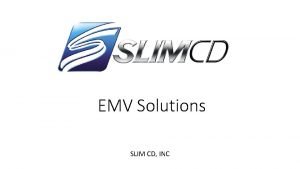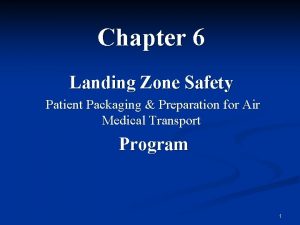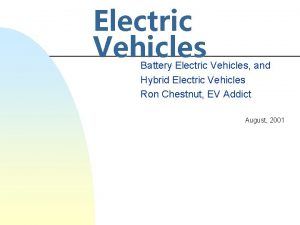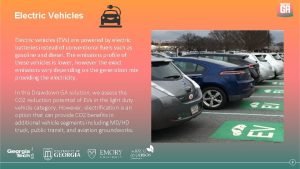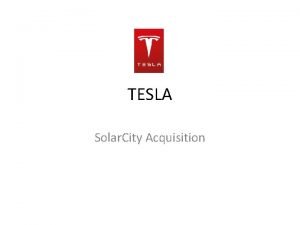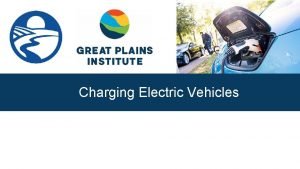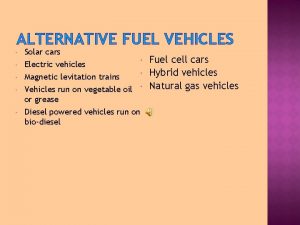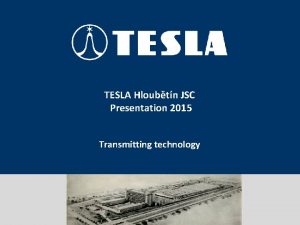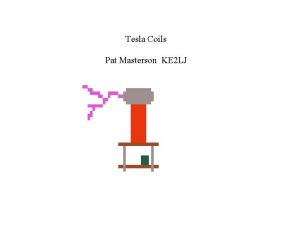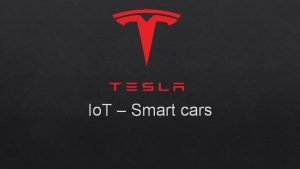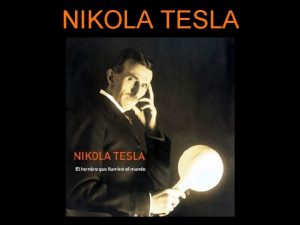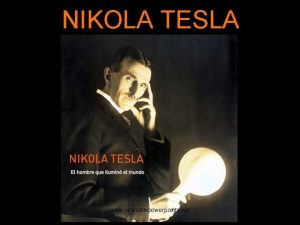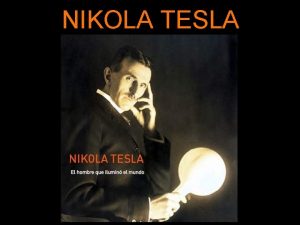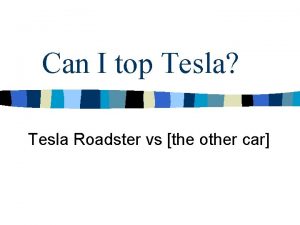Firefighting Considerations for Electric Vehicles Tesla Instructor Danny


































- Slides: 34

Firefighting Considerations for Electric Vehicles: Tesla Instructor Danny Braitsch Maryland Fire and Rescue Institute June 11, 2017

Objectives • Discuss the importance of continuing education on advancements of motor vehicle and their technology, including electric motor vehicles (e. g. Tesla Motors), as this industry continues to grow in popularity. • Describe the unique considerations an emergency responder should account for when responding to an emergency involving an electric vehicle, particularly a Tesla brand electric vehicle. • Understand the importance of and demonstrate the ability to disable the high voltage system and de-energize the vehicle. • Discuss the unique considerations an emergency responder should be aware of when responding to a vehicle extrication or fire involving a Tesla electric vehicle. • Describe the potential hazardous materials considerations that may arise in an emergency involving a Tesla electric vehicle.

Overview • Electric Vehicles • What are they? How prevalent are they? Where are they being sold? • Tesla Motors • First Responder Considerations to Tesla Vehicle Emergencies • • Disabling the High Voltage System Extrication considerations Fire considerations Hazardous materials considerations

Electric Vehicles

Electric Vehicles (EVs) are vehicles propelled by electric motors that are powered by rechargeable batteries. Similarly, plug-in hybrid vehicles are run by electric power, but have a supplemental gasoline engine in the event the battery powered electric engine runs out of charge. Because EVs are not equipped (as Hybrids are) with supplemental gasoline powered engines, they have more space for a larger battery, and thus a longer battery life.

Electric Vehicles in the U. S. • Electric Vehicle sales in the United States are second highest in the world, second only to China • The market for Electric Vehicles continues to grow OECD/IEA, 2016 Retrieved from https: //www. iea. org/publications/freepublications/publication/Global_EV_Outlook_2016. pdf

Nanalyze, 2017. Retrieved from: http: //www. nanalyze. com/2017/03/electric-cars-usa

Where are Electric Vehicles Being Sold? Nanalyze, 2017. Retrieved from: http: //www. nanalyze. com/2017/03/electric-cars-usa/


Tesla • Tesla dominates the electric vehicle market, with their Model S and Model X all-electric vehicles ranking within the top ten highest in sales in 2016. Model S was the top selling electric vehicle two years in a row. • Tesla intends to launch a more affordable Model 3 all-electric vehicle for its consumers in the near future.

Roadster Model S Model X All images retrieved from: https: //www. tesla. com/

Nanalyze, 2017. Retrieved from: http: //www. nanalyze. com/2017/03/electric-cars-usa/

First Responder Considerations to Tesla Vehicle Emergencies

Unique Hazards • Electric vehicles pose unique hazards on an emergency incident. • Electric engines are built and powered much differently than the morecommon and standard gasoline-powered engines that first responders are most familiar with. • Tesla and other electric vehicle manufacturers have developed emergency response guides for first responders to review in order to safely and efficiently mitigate emergencies involving electric vehicles. https: //www. tesla. com/firstresponders

Disabling the High Voltage System • Tesla Model S and Model X electric vehicles have labeled “cut-loops” for emergency responders to easily access • Located under the front hood on passenger side for Model S and Model X EVs • Double Cut cut-loop on Model S and Model X electric vehicles to cut high voltage energy supply to the vehicle • Once deactivated, the high voltage circuit may take approximately 2 minutes to deplete Retrieved from: https: //www. tesla. com/firstresponders

Disabling the High Voltage System • In earlier Tesla Model S vehicles (2014, 2015), the vehicle is equipped with a “first responder disconnect point” • Located at the rear pillar of the vehicle on the driver’s side • Shuts down the high voltage system and will disable both the SRS and airbag components • Used if cutting front trunk cut loop is not available • Manufacturer recommends using a 12” circular saw to cut 6 inches through the label and into the pillar • Not the first or best choice for disabling high voltage system • May pose unnecessary physical risk to backseat passengers Retrieved from: https: //www. tesla. com/firstresponders

Disabling the High Voltage System • Tesla Roadster 1. 5 equipped with an Emergency Disconnect • Located under the trunk above the rear passenger wheel • Ensure the power is off in Tesla Roadster 1. 5 before cutting the Emergency Disconnect • Once deactivated, the high voltage circuit may take approximately 5 minutes to deplete Retrieved from: https: //www. tesla. com/firstresponders

Disabling the High Voltage System • Tesla Roadster 2. 0 and 2. 5 equipped with an Emergency Disconnect • Located under the hood on the driver’s side • Ensure the power is off in Tesla Roadster 2. 0 and 2. 5 before cutting the Emergency Disconnect • Once deactivated, the high voltage circuit may take approximately 5 minutes to deplete Retrieved from: https: //www. tesla. com/firstresponders

Disabling the High Voltage System • Note that Tesla vehicles, when running, make virtually no sound. Responders must be mindful to ensure the power is cut-off to the vehicle and should not assume that the power source has been secured based on lack of noise from the vehicle

Extrication Considerations • Stabilizing the Vehicle • For Tesla EVs, manufacturer recommends shifting the vehicle into park and chocking all wheels of the vehicle • In incidents involving a Tesla brand EV overturned or on-its-side, emergency responders must be mindful not to penetrate the High Voltage Battery • Located beneath the floor plan in all Model S and Model X models • Located behind the seats in the trunk area for Tesla Roadster models • Per Tesla manufacturer warning: • “DO NOT USE THE HIGH VOLTAGE BATTERY AREA TO LIFT OR STABILIZE MODEL S. ”

Extrication Considerations • Lift Areas • For its Model S and Model X electric vehicles, Tesla designates “lift areas, ” or safe areas in which the vehicle can be lifted or jacked, accounting for the high voltage battery located underneath the floor pan. • These lift areas are on the flanks of the vehicles on either driver or passenger side Retrieved from: https: //www. tesla. com/firstresponders

Extrication Considerations • Airbags • Similar to any vehicle, emergency responders must be mindful during extrication about the risk of cutting into airbags and airbag (stored gas) cylinders • Per Tesla Manufacturer Warning: “The SRS control unit has a backup power supply with a discharge time of approximately ten seconds. Do not touch the SRS control unit within ten seconds of an airbag or pretensioner deployment. ”

Extrication Considerations • No-Cut Zones • Per Tesla Manufacturer Warning, the Model X and all Model S electric vehicles have areas that are defined as “’no-cut zones’ due to high voltage, gas struts, SRS components, airbags, or other hazards. Never cut or crush in these areas. ”

Extrication Considerations • Falcon-wing Doors • The Model X Tesla EV boasts falcon-wing doors. While other non-electric vehicles have similar features, it is imperative that emergency responders train and discuss with their companies to be prepared for unique circumstances. • Dash Displacement Considerations • For Model S and Model X vehicles, the DC-DC converter and front junction box are located in the area of the dash, either driver’s side, center, or passenger’s side. This may pose a hazard during dash lift/roll extrication procedures. Manufacturer recommends using work-around techniques if necessary.

Fire Considerations Emergency Responder Safety • If the electric vehicle is on fire and connected to a charging station, control utilities and ensure the power is off before applying water. Until utilities are secure, treat this scenario as a Class C fire. • Always assume the high voltage battery and all exposed orange cables are energized. • Always wear full PPE including SCBA

Fire Considerations • Tesla EVs are not statistically more likely to ignite than any other vehicle on the road • Small fires that do not involve the high voltage battery may be extinguished using typical firefighting methods, being mindful not to make contact with the high voltage system or its components during overhaul procedures

Fire Considerations • High Voltage Battery fire involvement • May take up to 24 hours to extinguish, depending on extent of involvement. Consider requesting additional resources or letting the battery continue to burn while protecting exposures

Fire Considerations • Use a TIC to ensure the HV battery has cooled. Smoke or steam indicates continued presence of heat. • Per Tesla recommendation: • Do not release the vehicle to law enforcement or towing personnel until there has been no heating detected for one hour. • Due to risk of re-ignition, Tesla recommends storing the fire damaged vehicle in an open area at least 50 ft from exposures

Hazardous Materials Considerations • If the high voltage battery receives fire damage, it can release toxic vapors including sulfuric acid, oxides of carbon, nickel, aluminum, lithium, copper, and cobalt. volatile phosphorous pentafluoride may form at temperatures above 230 o Fahrenheit. • Full PPE including SCBA recommended • Use fog streams and PPV fans to redirect these vapors if necessary

Hazardous Materials Considerations • Lithium-ion Battery • The HV is comprised of lithium-ion cells, which are considered dry cell batteries and if damage may leak a small amount of clear battery fluid • Components of the Tesla electric motors are liquid cooled with a glycol-based, blue-colored fluid, which may leak out if these components are damaged • Front carrier on the rear wheel drive Model S is magnesium

Video Presentations Tesla EV Safety Training See Video Tesla Model X First Responder Training - Advanced Extrication See Video Tactical Considerations for Extinguishing Fire in Hybrid and Electric Vehicles See Video

Review • Electric Vehicles • What are they? How prevalent are they? Where are they being sold? • Tesla Motors • First Responder Considerations to Tesla Vehicle Emergencies • • Disabling the High Voltage System Extrication considerations Fire considerations Hazardous materials considerations

More Resources • While Tesla may be the face of the Electric Vehicle market, there are many other EVs on the road and it is important for first responders to make themselves familiar with the unique emergency response considerations for all. • NFPA Collection of Safety Manuals and First Responder Information on all EVs and Hybrid Vehicles: http: //www. evsafetytraining. org/resources/auto-manufacturer-resources. aspx • NFPA Alternative Fuel Vehicles Safety Training Program - Emergency Field Guide may be obtained free of charge at: http: //www. evsafetytraining. org

References Archer, Brock. (2016). Tesla EV safety training video. Advanced Extrication. Retrieved from: http: //advancedextrication. com/2013/03/tesla-ev-safetytraining-video/. International Energy Agency. (2016). Global EV outlook 2016: Beyond one million electric cars. International Energy Agency Publications, 2016. Retrieved from https: //www. iea. org/publications/freepublications/publication/Global_EV_Outlook_2016. pdf. Nanalyze. (2017). How many electric cars are there in the USA? Nanalyze. Retrieved from http: //www. nanalyze. com/2017/03/electric-cars-usa. [National Fire Protection Agency]. (2014, Dec 9). Tactical considerations for extinguishing fires in hybrid and electric vehicles [Video File]. Retrieved from: https: //youtu. be/mt. Ck 3 sr. ID_w. Tesla Motors Inc. (2009). Roadster: Emergency Response Guide. Palo Alto, CA: Tesla. Retrieved from: https: //www. tesla. com/firstresponders. Tesla Motors Inc. (2013). Model S 2013: Emergency Response Guide. Palo Alto, CA: Tesla. Retrieved from: https: //www. tesla. com/firstresponders. Tesla Motors Inc. (2014). Model S 2014: Emergency Response Guide. Palo Alto, CA: Tesla. Retrieved from: https: //www. tesla. com/firstresponders. Tesla Motors Inc. (2015). Model S 2014 -2015 AWD Dual Motor: Emergency Response Guide. Palo Alto, CA: Tesla. Retrieved from: https: //www. tesla. com/firstresponders. Tesla Motors Inc. (2016). Model S 2016: Emergency Response Guide. Palo Alto, CA: Tesla. Retrieved from: https: //www. tesla. com/firstresponders. Tesla Motors Inc. (2016). Model X 2016: Emergency Response Guide. Palo Alto, CA: Tesla. Retrieved from: https: //www. tesla. com/firstresponders.
 Special protective equipment used in firefighting except
Special protective equipment used in firefighting except Rotary control valve firefighting
Rotary control valve firefighting Chimney chains firefighting
Chimney chains firefighting Tactical ventilation
Tactical ventilation Receo vs fire
Receo vs fire Bam bam tool firefighting
Bam bam tool firefighting 18 watchout situations for wildland firefighters
18 watchout situations for wildland firefighters Condensed q method friction loss
Condensed q method friction loss Fire fighting methods
Fire fighting methods Electrical potential energy
Electrical potential energy Units of charge
Units of charge Electric field and electric potential
Electric field and electric potential Units of a charge
Units of a charge Electric field to energy
Electric field to energy A suitable electric pump in an electric circuit is a
A suitable electric pump in an electric circuit is a Electric charges and electric forces lesson outline
Electric charges and electric forces lesson outline Potential energy of a system of charges
Potential energy of a system of charges Chapter 21 electric charge and electric field
Chapter 21 electric charge and electric field Chapter 21 electric charge and electric field
Chapter 21 electric charge and electric field General considerations in machine design
General considerations in machine design Ethical considerations in research example
Ethical considerations in research example Capk expired
Capk expired Biopharmaceutic considerations in drug product design
Biopharmaceutic considerations in drug product design Mechanical design of transmission line
Mechanical design of transmission line Eswl anesthesia considerations
Eswl anesthesia considerations Ethical considerations examples
Ethical considerations examples What is a costume
What is a costume Acclimatisation pdhpe
Acclimatisation pdhpe Collaboration design considerations
Collaboration design considerations Writing strategies and ethical considerations
Writing strategies and ethical considerations Tax considerations for setting up a new business
Tax considerations for setting up a new business Azure landing zone considerations
Azure landing zone considerations Design considerations for mobile computing
Design considerations for mobile computing Retromylohyoid fossa classification
Retromylohyoid fossa classification Database design considerations
Database design considerations





















